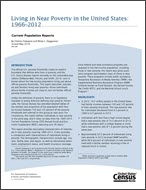Living in Near Poverty in the United States: 1966-2012
Living in Near Poverty in the United States: 1966-2012
Introduction
The official U.S. poverty thresholds create an explicit boundary that defines who lives in poverty, and the U.S. Census Bureau reports annually on this vulnerable population (DeNavas-Walt, Proctor, and Smith, 2013). Less is known about the low-income population living just above official poverty thresholds. This report describes individuals and families living near poverty—those individuals whose family incomes are close to, but not below, official poverty thresholds.
Unlike the definition of poverty, there is no legislative mandate or policy directive defining near poverty. Historically, the Census Bureau has provided detailed tables of the number and proportion of the population with family income between 100 and 125 percent of the poverty thresholds and referred to this group as near poor. For consistency, this report defines individuals in near poverty in the same way, and it relies on data from the 1967–2013 Current Population Survey (CPS) Annual Social and Economic Supplement (ASEC) spanning over 45 years.2
This report provides descriptive characteristics of individuals in near poverty covering 1966–2012. It also provides a comparison with characteristics of individuals living in poverty. The demographic characteristics include age, sex, race, family type, and region, as well as educational attainment, employment status, and health insurance coverage.
Since federal and state assistance programs are targeted to the low-income population, including those in near poverty, this report also gives assistance program participation rates of those in near poverty. These programs include public assistance, Temporary Assistance to Needy Families (TANF), the Supplemental Nutrition Assistance Program (SNAP, formerly known as Food Stamps), the Earned Income Tax Credit (EITC), and the National School Lunch Program.3
__________
1 Charles Hokayem is an Economist in the Poverty Statistics Branch at the U.S. Census Bureau. Misty L. Heggeness is a Labor Economist at the National Institutes of Health. The analysis in this report was conducted while Misty Heggeness was employed by the U.S. Census Bureau.
2 This report uses the first available and most recently available CPS ASEC, 1967 and 2013, respectively.
3 Public assistance programs include Aid to Families With Dependent Children (AFDC) and TANF.
Highlights
- In 2012, 14.7 million people in the United States had family incomes between 100 and 125 percent of their poverty threshold. The near-poverty rate for individuals decreased from 6.3 percent in 1966 to 4.7 percent in 2012.
- Individuals with less than a high school degree had a near-poverty rate of 10.0 percent in 2012, while individuals with a college degree or more had a near-poverty rate of 1.6 percent during the same year.
- Approximately 32.5 percent of individuals living near poverty in 2012 received SNAP benefits, while 84.6 percent of individuals in near poverty lived with a family member receiving a free or reduced lunch in school.
- In 2012, about 20.7 percent of individuals in near poverty qualified for the EITC. In contrast, 16.7 percent of individuals in poverty qualified for the EITC.
- In 2012, the share of the near-poverty population covered by public health insurance was 43.6 percent, while the share of the poverty population covered by public health insurance was 50.2 percent.
- From 2011 to 2012, the flow of individuals exiting near poverty was statistically unchanged from the flow of individuals entering near poverty.
- From 2010 to 2012, 18 states had a 3-year average near-poverty rate lower than the national average; 12 states had a 3-year average near-poverty rate higher than the national rate; and 20 states and the District of Columbia had a 3-year average near-poverty rate not statistically different from the national average.
Others in Series
Publication
Publication
Publication




